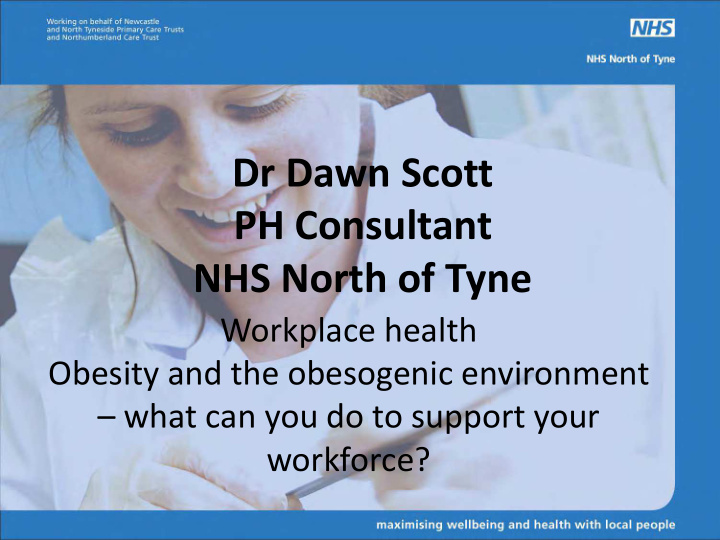



Dr Dawn Scott PH Consultant NHS North of Tyne Workplace health Obesity and the obesogenic environment – what can you do to support your workforce?
Good Health is Good Business Considerations - Workplace Health • Effects of Health on Work • Effects of Work on Health
Effects of one’s Health on Work Preventing ill-health through health promotion in or through the workplace (primary prevention) in relation to work related and non work related issues Managing chronic ill health / health conditions whilst employed (secondary prevention) Preparing for retirement / succession planning
Healthy Workplace The effects of Work on Health Diverse and varied depending on workplace – but underpinned by Health, Safety and welfare legislation Our working environment can have • Effects on physical health • Effects on emotional Health Health & safety education & training and health promotion are key to ensuring a happy healthy and productive workforce
Shift patterns • “Normal” hours of work are generally taken to mean a working day with hours left for recreation and rest. Rest is a night time activity, work a daytime activity. • Shift patterns can both enhance and hinder one’s opportunities to take regular exercise and/or eat healthily • Physical fitness appears to help workers cope with shift work (advice on exercise, diet and sleep management) Occup Environ Med 2001; 58: 68-72 doi:10.1136/oem.58.1.68
Strategy for health promotion in the workplace • health education / promotion to raise awareness of factors affecting health and well-being (Knowledge / informed choice) • action programmes e.g. walking groups; workplace weight management • screening programmes to detect risk factors or early signs of disease (specific to certain work places)
TOOL D7 What success looks like – changing behaviour • More workplaces that promote healthy eating and activity, with the public sector acting as an exemplar, both through the location and design of the buildings on the government estate and through staff engagement programmes • Everyone able to access appropriate advice and information on healthy weight • Increasing numbers of overweight and obese individuals able to access appropriate support and services Healthy Weight, Healthy Lives: A toolkit for developing local strategies 2008
Health promotion in the work place • Improves access to health information, advice and guidance • May / should improve access to health promoting activities • Improves the emotional health and well being of employees • Increases productivity (quality / quantity)
Obesity - Extent of the problem across North of Tyne • Using the ‘Lighten the Load Ready Reckoner’ it is estimated that 141,161 working age adults (16-74 year olds) across North of Tyne are obese (BMI greater than 30kg/m2) Based on Health Survey for England 2006
Area and Gender Breakdown • Newcastle 23,954 males / 23,757 females • North Tyneside 17,429 males / 18,049 females • Northumberland 28,741 males / 29,228 females Based on Health Survey for England 2006 – (16-74 year olds)
BMI prevalence in the workplace • Job activity levels (strenuous, active and sedentary) have an impact on musculoskeletal disorders (MSD) in employees – a high BMI (> 30) increases MSD especially lower body and low back pain disorders • Older age and high BMI together are more likely to give rise to lower body MSD • ‘Constructing better health study’ (Construction industry workers) – 16% of workers obese - more likely if less skilled • It is suggested that obesity increases problems of health, reduces the chances of recovery and increases the risk of death (Christensen et al ., 2009) • BMI of >30 can restrict work for some professions (Divers) • NHS organisations have had to make significant changes to workplace practice and invest in high cost equipment to deal with the increasing number of bariatric patients admitted • Chronic obesity was a particularly strong predictor of long absences in men (Whitehall study, 2007) Findings from this well-characterized cohort suggest that the obesity epidemic in industrialised countries may result in significant increases in sickness absence.
Causal factors
Workplaces are excellent settings for tackling obesity • Invite health trainers into you workplace setting • Encourage regular health checks (in or out of work) – early intervention • Olympic year – a once in a lifetime opportunity to incentivise your work force
Addressing causal factors in the workplace • Increasing opportunities to improve access to and uptake of physical activity • Changing the physical working environment (encourage stairs not lifts) • Improving food availability at work e.g. healthy canteen food / removal of vending machines • Encouraging healthy modes of travel to and from work • Offer workplace support especially where shift patterns hinder regular attendance to non work support • Provide information, advice and guidance about healthy lifestyles and work based weight management programmes
Recommend
More recommend